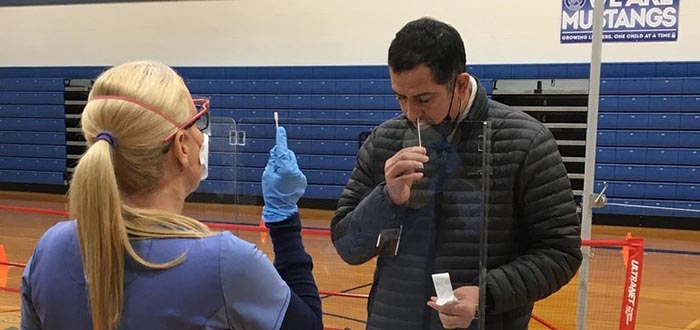
Districts are having to limit testing to return to school and contact tracing, though some experts suggest omicron signals the virus’ transition to endemic.
From K-12 Dive
By Naaz Modan
Jan. 13, 2022
Amid growing test shortages and virus spread, school districts are scaling back COVID-19 precautions despite data from the Centers for Disease Control and Prevention indicating COVID-19 transmission is high in nearly 100% of counties nationwide.
In Connecticut, where districts are grappling with staffing shortages caused by high virus spread, Enfield Public Schools recently announced it would no longer require negative test results as a condition for return to school or work following COVID-19 exposure and infection.
“This is not something I take lightly, but because testing is so scarce, it is something that we have no choice in implementing,” said Superintendent Christopher Drezek in a notice to the community. “The fact that we are two years into this pandemic and the testing situation is so bad is an argument for another day. For now, we have to continue to do the best we can with the resources we have.”
According to a survey conducted Jan. 7-10 and released by the state’s board of education union coalition, 61.8% of 5,686 respondents across the state said they lack the supplies and protocols to feel safe performing their job responsibilities.
The situation is similar in other places across the nation.
According to an informal membership survey by Chiefs for Change,a nonprofit organization and bipartisan network of state and district education leaders, 80% say they are either out of tests or will be soon, and 90% say their community is experiencing test shortages.
“That is a real crisis,” said Mike Magee, CEO of the organization. “It makes meeting the challenges of this moment in the pandemic very difficult.”
The challenges come as districts are reporting a significant number of students and staff absences because of COVID spread. For example, the Los Angeles Unified School District, which serves over 600,000 students at more than 1,000 schools, recently reported 78,074 positive COVID-19 cases among students and staff and 30% of students as absent.
“This makes regular testing — including a test to leave isolation — as well as well-fitting masks, ventilations and of course, vaccines and boosters, all the more important to keep the entire education community safe,” said Randi Weingarten, president of the American Federation of Teachers, in an emailed statement to K-12 Dive.
Linda Mendonca, president of the National Association of School Nurses, said prevention measures adopted by communities, such as testing to leave isolation, depend largely on the rate of community transmission and availability of resources, which vary from place to place.
As a result, districts are narrowing testing to only symptomatic individuals or forgoing testing as a requirement to return to the classroom. Some are also having to pare back on contact tracing due to dramatic increases in case numbers.
“With the increase of cases, I think that schools are looking at different ways of handling the contact tracing and doing all of that,” Mendonca said. “There’s definitely some shift in how things are handled with this surge.”
Pandemic safety guidelines changing too much, or not enough?
Local policies and new CDC guidance, which does not suggest a negative test to return to school after exposure, are also making it difficult for districts to know how to shift their own COVID-19 health precautions.
Seattle Public Schools in Washington state, which previously required students exposed to COVID-19 to provide proof of negative test results, recently updated its guidelines to no longer require a negative test for in-person learning.
“SPS does not have the authority to require a negative test as a condition of attending school,” said the district’s guidance updated Jan. 7.
Rapidly shifting guidance, meanwhile, fractures trust between school administrators, nurses and the larger community, Mendonca said.
However, Magee said guidance at different levels of government actually isn’t shifting rapidly enough. Sometimes contradictory federal, state and local guidance is leaving administrators in a bind, Magee said
“That is not helpful to schools,” Magee said, adding schools are mostly tied to guidance from their state and local health agencies. “It’s a lot to ask school leaders or district leaders to buck the guidance they’re getting from state and local health agencies, even if they think it’s in the best interest of kids.”
Most of the time, district leaders are advocating and waiting, Magee said.
Shifting approach to long-term safety measures
Acknowledging the nationwide test shortages, the U.S. Department of Education Wednesday announced it would increase the number of COVID-19 tests available to schools by 10 million per month.
Some don’t think that will be enough, considering that that amounts to 1 in 5 students being tested once per month, according to calculations from education policy experts.
Magee instead has suggested a “stockpiling” approach for masks and tests potentially provided by the federal government as variants transition the virus from pandemic to endemic, comparing the strategy to states that stock up on salt for inclement weather during winters.
“I think we are entering this period where it is very likely that we are going to be dealing with a nasty endemic virus for a minimum [of] the next few years,” Magee said. “What struck me … is this idea that we plan for emergencies, and we don’t, in fact, stop buying salt if we haven’t had a bad snowstorm in two years. We keep buying salt because one of them is going to come eventually.”
Photo: Permission granted by Roy Mendiola
Read this and other stories at K-12 Dive

